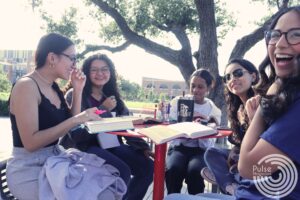Stuck Between Two Cultures or Just Stuck in One?
Illustrations by: Sol Santana
Being told you come from neither here nor there and believing that statement can confuse someone trying to navigate and find their identity. People often look at the spectrum and place themselves in the range they feel mostly identifies them.
The common misconception is that everything is made up of something that adds up to 100%. However, there is a pool of people that may be 200 percenters, 300 percenters, and so on. By “percenters,” I mean how a person can carry 100% of each culture. For example, I am American with Mexican parents; I strongly identify with both cultures and carry 100% of each one wherever I go. Often, I tend to find myself stuck between both my Mexican and American roots when asked about my preferences, my political views, my personality traits, and how I speak. In other words, it has led me to believe that I should only place 100% of one of my cultures into a box…
Is there only one box we fit into? Is there no such thing as summing up to a larger quantity than 100%? Is it wrong not to be 100% loyal to just one side? By sides, I mean political parties, cultural backgrounds, and everything that comes with that. What tops the cake is when I get asked a series of questions such as “Are you here illegally?” “I did not know you were Mexican until you talked because you look white,” “You’re too white to be Mexican,” “Why do you want to have a career?” or “Don’t Mexican women become housewives?”. Inevitably, people’s misconceptions and judgment of Hispanic or bicultural people can create a blockage in identity formation, and the flow of talent and creativity a person may possess may never be noticed and praised.
I came from a family that had the idea embedded that women are expected to become housewives and not play a role in any particular industry. My grandmother and mother both made their maternal side a part of their career and never poked through their capabilities in excelling at a professional, fulfilling career. They made it seem as though their only option was to stay home and tend to the house and family, when nowadays, women have proven that they can do both. I thank the American culture for shaping me into the woman I am. My eyes were opened to the idea that, like a man, I can get a career that I am passionate about and mark my stamp into the world. However, “machismo” dominates a big part of Mexican culture, not to reach their fullest potential. The New York Times defines “machismo” as the sense of having strong and aggressive masculine pride.
Some Mexican men tend to feel intimidated by powerful, confident women, creating a prominent caste system that harms the flow of humanity’s ecosystem. According to The Michigan Daily, countries like Mexico have cut off the budget of the Federal Women’s Institute. This affected Mexican women greatly because the agency aimed at gender equity by 75%, which is a great opportunity for advancement for women’s advantage. According to The New York Times, the World’s Economic Forum’s latest Global Gender Gap Report, shows that the United States and Mexico’s gender gaps are almost the same. I blame the media’s depiction showing how the “system” should. Although it is more severe in Mexico, the rest of the world still needs some advancement in helping that issue. In the future, I hope my Mexican and American attributes, my involvement in bringing awareness to bicultural and gender issues, will
contribute both of my culture’s moralistic values to people around the world. I grew up in a home where family always came first. There was no escaping from my family. They were always around whether I wanted them there or not. Mexican culture is notoriously known for exercising family as the No.1 priority, creating a safety net of support, love, and protection. Something I noticed about my extended family that lived in Austin, was how they rarely saw their extended family and how that time was only applicable for the holiday season.
Seeing that as a Mexican-American allowed me to combine both culture’s work and family values, into my own. My mother’s American values, into my own. My mother’s American values, combined with my father’s Mexican values, collided into my formation of becoming independent at a young age searching for that sense of self-worth in a profession and ensuring my Mexican characteristics of creating an overloving support system continue to the further generations.
Being fluent in English and Spanish can be confusing when trying to communicate with each individual culture. Imagine having to speak English, but while trying to bring those words out of you, you are thinking of them in Spanish. Sometimes certain words just sound better in Spanish and trying to translate them to English, or vice versa, just feels wrong. In this case, the only solution I have been able to find is to use that to my advantage. If something sounds better to me in the opposite language I am trying to communicate, I try to explain it to the person as a conversation starter.
This serves as a bonding experience because most of the time, some things sound better in Spanish, so the other person gets a laugh and learns something new about their opposing culture. It has happened to me when I have been on family vacations with my extended family. They identify more on the American side; therefore their Spanish-speaking ability is not as strong as it was before. They have heard me and my brothers have conversations where I will ask them something in English, and they respond with a funny remark in Spanish. My extended family has pointed it out as an “interesting” and “fun” way of communicating that we could use to our advantage.
When interviewed about the main differences she finds in Mexican and American culture, student Anna Camila Guerrero, a current University of Texas Rio Grande Valley (UTRGV) student majoring in Finance, felt the most significant difference is political issues. “I am proud to be Mexican-American, but I can’t help but feel some shame from my home country. The inconsistency in securing the nation’s issues has continued for generations. The country is full of corrupt, cold-hearted leaders, and from what I can gather, it will be impossible to revoke the perverse system”, said Anna Camila.
She also said that, “The United States has served as a chain of opportunities for many immigrants, and we all know the contributions made by immigrants strengthened America into the power house it is today. What makes the U.S. a home for its citizens is the diversity dispersed throughout the country which is when the shame of my home country, Mexico, fades away. If the United States, the leading country of the world, gives people of different backgrounds the privilege to contribute to the free life everyone should be granted, it reminds me that my culture brings something to the table and the negative aspects of my country do not define me.”
The power of being multicultural gives us the advantage to persuade and convert the world into installing new systems, in which gender, race, and culture will continue to matter, but not for the use of separation, for the benefit of uniting. The United States is somewhat ahead in those matters. However, the time will come when eventually, every country will have to shapeshift into the normalcy of uniting everyone.
What makes the United States a home for its citizens is the diversity dispersed throughout the country. The plethora of cultures and backgrounds give the U.S. its status, inclusivity, and reputation as “the land of the free.” My Mexican roots contribute to that. So, the next time they ask me where I come from, I will state how I am a 200 percenter, that I am from here and there, how I hope I can one day in the future become a 300, 400, 500 percenter. I will say where my origin is, where I developed my identity and where I will carry myself along with everything I have to give.








